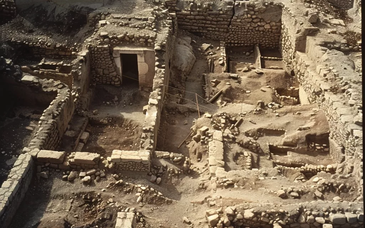Cedars of LebanonThe common thought is Noah alone, or with the help of his sons built the Ark. A ship of this size being built by one man, or even by four or five men seems quite impossible. To begin this discussion we should first determine just how large the Ark actually was? In Genesis 6:15 we are told the Ark is to be built 300 cubits by 50 cubits by 30 cubits. A cubit was the distance between a man's elbow and his finger-tip. As this will vary from one person to another, it is impossible to determine exactly how long a cubit was for Noah. The generally accepted length of a cubit is considered to be 18 inches.
When we apply the accepted length of a cubit to the Biblical measurements we can determine the Ark was approximately 450 feet long, 75 feet wide and almost 45 feet tall. Estimates show the Ark would have had a displacement of 21,016 tons. To put it in perspective, no ship of this size would be built again until the 1800's.
The materials for the Ark were wood. Once again using estimates, Noah would have needed approximately 800 trees which were over 32 feet in height and three feet in diameter. The wood needed to build the Ark would have weighed approximately 4,000 tons. Harvesting and preparing this amount of wood would have been a formidable task, not to mention the construction required after the raw materials were prepared. I believe it is very clear Noah did not build the Ark by himself and would have required more help than his sons alone could have provided.
Does this mean the Ark could not be, or was not built? Absolutely not. While it seems clear the physical task was too large for one man, the Bible does not tell us Noah worked alone and there is no reason to assume he did.
It was mentioned earlier Noah was a man of the soil and after the Ark came to rest started a Vineyard. It would seem logical Noah had a similar operation prior to the flood. If so, it is certainly possible Noah was a man of some wealth. Archeological evidence indicates wine production was very rare, and thus anyone with the means to produce wine would have had a commodity which was in great demand. Knowing the Earth was about to be destroyed, Noah would have had no reason not to sell his possessions or spend his savings in order to hire workers. A job which would be difficult for a single man becomes much more manageable when you have 100, 200, or even 500 men working on that same project.
There are several questions surrounding the size of the ark in relation to the materials reported to have been used in its construction. Can a ship 450 feet in length be made of wood? Does wood have the strength to support this type of vessel, especially when at sea? Has there ever been a wooden ship 450 feet in length? It seems the logical place to start is to compare the reported size of the ark with other wooden vessels built throughout history.
Comparison of wooden ships:
- Grace Dieu - 218 feet long (1420-1439)
- HMS Sovereign of the Seas - 249 feet long (1637-1676)
- Caligula's Giant Ship - 341 feet long (37A.D.)
- Rochambeau 377 feet long (1865-1874)
- Noah's Ark 450 feet long
As this comparison shows Noah's Ark would have been the largest wooden ship ever constructed. There have been numerous wooden ships constructed over 300 feet in length, one even as early as 37 A.D, but even given this, some critics believe wood does not have the strength to be used in the building of a ship the size of Noah's Ark. This seems to contradict history as we can see vessels have been constructed and sailed which have approached the 400 foot mark.
The Bible tells us the Ark's overall dimensions and that is was to be built with three decks, but we are given no details of what engineering practices were used in its construction. When it is stated a wooden structure of this size could not be built, the statement is one contrary to historical evidence when compared to a final example of a wooden vessel, the Greek Ship Tessarakonteres. This ship was reportedly 420 feet long and was built in 200 B.C. The ship was so large it is said to have been powered by 4,000 oarsmen and could carry over 2,800 soldiers along with catapults. The overall dimensions of this grand ship were said to be 420 feet in length, 58 feet wide and 80 feet in height. These numbers are very close to those given for Noah's Ark. This ship alone shows a wooden ship with the dimensions of the Ark could have been built, and the materials would have been strong enough to support such construction.
One more interesting note concerning large wooden ships in ancient times. In the records of Pharaoh Snefru, who ruled in approximately 2600 B.C. he records how he imported more than 40 ship loads of Cedar wood from Lebanon. He then goes on to boast how he used the wood to built a ship 1,700 feet long.That is nearly four times the length of Noah's Ark. No other record or evidence of this enormous ship is known to exists, but it is a most remarkable discovery and leaves us to wonder if the claim is true, and if so, was this massive ship ever put to sea?
The evidence suggests building a wooden ship to the dimensions given in the Bible is certainly possible. Fortunately for our discussion we have a final piece of proof. In 2012 Johan Huibers, a Dutchman who is also a millionaire, finished the construction of a full size replica of the Ark. The ship, which is stable on the water, measures 427 feet long, 95 feet wide and 75 feet in height. The task took Huibers twenty years to complete. Huibers insists the new ark has nothing to do with the end times and is intended solely as an educational tool. Inside the ark Huibers has included a small restaurant, a movie theater, historical displays and hands on displays for children. Concerning the project Huibers had the following comment;
"You might know the story of Noah, okay, but if you see this you begin to get an idea of how it would actually have worked in practice."



